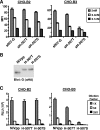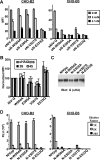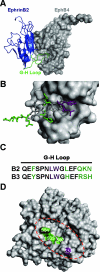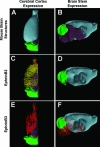Single amino acid changes in the Nipah and Hendra virus attachment glycoproteins distinguish ephrinB2 from ephrinB3 usage
- PMID: 17652392
- PMCID: PMC2045465
- DOI: 10.1128/JVI.00999-07
Single amino acid changes in the Nipah and Hendra virus attachment glycoproteins distinguish ephrinB2 from ephrinB3 usage
Abstract
The henipaviruses, Nipah virus (NiV) and Hendra virus (HeV), are lethal emerging paramyxoviruses. EphrinB2 and ephrinB3 have been identified as receptors for henipavirus entry. NiV and HeV share similar cellular tropisms and likely use an identical receptor set, although a quantitative comparison of receptor usage by NiV and HeV has not been reported. Here we show that (i) soluble NiV attachment protein G (sNiV-G) bound to cell surface-expressed ephrinB3 with a 30-fold higher affinity than that of sHeV-G, (ii) NiV envelope pseudotyped reporter virus (NiVpp) entered ephrinB3-expressing cells much more efficiently than did HeV pseudotyped particles (HeVpp), and (iii) NiVpp but not HeVpp entry was inhibited efficiently by soluble ephrinB3. These data underscore the finding that NiV uses ephrinB3 more efficiently than does HeV. Henipavirus G chimeric protein analysis implicated residue 507 in the G ectodomain in efficient ephrinB3 usage. Curiously, alternative versions of published HeV-G sequences show variations at residue 507 that can clearly affect ephrinB3 but not ephrinB2 usage. We further defined surrounding mutations (W504A and E505A) that diminished ephrinB3-dependent binding and viral entry without compromising ephrinB2 receptor usage and another mutation (E533Q) that abrogated both ephrinB2 and -B3 usage. Our results suggest that ephrinB2 and -B3 binding determinants on henipavirus G are distinct and dissociable. Global expression analysis showed that ephrinB3, but not ephrinB2, is expressed in the brain stem. Thus, ephrinB3-mediated viral entry and pathology may underlie the severe brain stem neuronal dysfunction seen in fatal Nipah viral encephalitis. Characterizing the determinants of ephrinB2 versus -B3 usage will further our understanding of henipavirus pathogenesis.
Figures








Similar articles
-
Two key residues in ephrinB3 are critical for its use as an alternative receptor for Nipah virus.PLoS Pathog. 2006 Feb;2(2):e7. doi: 10.1371/journal.ppat.0020007. Epub 2006 Feb 10. PLoS Pathog. 2006. PMID: 16477309 Free PMC article.
-
Efficient reverse genetics reveals genetic determinants of budding and fusogenic differences between Nipah and Hendra viruses and enables real-time monitoring of viral spread in small animal models of henipavirus infection.J Virol. 2015 Jan 15;89(2):1242-53. doi: 10.1128/JVI.02583-14. Epub 2014 Nov 12. J Virol. 2015. PMID: 25392218 Free PMC article.
-
Molecular recognition of human ephrinB2 cell surface receptor by an emergent African henipavirus.Proc Natl Acad Sci U S A. 2015 Apr 28;112(17):E2156-65. doi: 10.1073/pnas.1501690112. Epub 2015 Mar 30. Proc Natl Acad Sci U S A. 2015. PMID: 25825759 Free PMC article.
-
Henipavirus membrane fusion and viral entry.Curr Top Microbiol Immunol. 2012;359:79-94. doi: 10.1007/82_2012_200. Curr Top Microbiol Immunol. 2012. PMID: 22427111 Review.
-
Envelope-receptor interactions in Nipah virus pathobiology.Ann N Y Acad Sci. 2007 Apr;1102(1):51-65. doi: 10.1196/annals.1408.004. Ann N Y Acad Sci. 2007. PMID: 17470911 Free PMC article. Review.
Cited by
-
New insights into the Hendra virus attachment and entry process from structures of the virus G glycoprotein and its complex with Ephrin-B2.PLoS One. 2012;7(11):e48742. doi: 10.1371/journal.pone.0048742. Epub 2012 Nov 5. PLoS One. 2012. PMID: 23144952 Free PMC article.
-
Genomic characterization, transcriptome analysis, and pathogenicity of the Nipah virus (Indian isolate).Virulence. 2023 Dec;14(1):2224642. doi: 10.1080/21505594.2023.2224642. Virulence. 2023. PMID: 37312405 Free PMC article.
-
Cysteines in the stalk of the nipah virus G glycoprotein are located in a distinct subdomain critical for fusion activation.J Virol. 2012 Jun;86(12):6632-42. doi: 10.1128/JVI.00076-12. Epub 2012 Apr 11. J Virol. 2012. PMID: 22496210 Free PMC article.
-
Multivalent viral particles elicit safe and efficient immunoprotection against Nipah Hendra and Ebola viruses.NPJ Vaccines. 2022 Dec 17;7(1):166. doi: 10.1038/s41541-022-00588-5. NPJ Vaccines. 2022. PMID: 36528644 Free PMC article.
-
A broad-spectrum antiviral targeting entry of enveloped viruses.Proc Natl Acad Sci U S A. 2010 Feb 16;107(7):3157-62. doi: 10.1073/pnas.0909587107. Epub 2010 Jan 28. Proc Natl Acad Sci U S A. 2010. PMID: 20133606 Free PMC article.
References
-
- Aguilar, H. C., O. A. Negrete, K. A. Matreyek, D. Y. Choi, and B. Lee. 2006. Annu. Meet. Am. Soc. Virol., abstr. P19-4. American Society for Virology, Madison, WI.
-
- Anonymous. 2004. Person-to-person transmission of Nipah virus during outbreak in Faridpur District, 2004. Health Sci. Bull. 2:5-9.
Publication types
MeSH terms
Substances
Grants and funding
- AI060694/AI/NIAID NIH HHS/United States
- R01 AI060694/AI/NIAID NIH HHS/United States
- GM07185/GM/NIGMS NIH HHS/United States
- R21 AI059051/AI/NIAID NIH HHS/United States
- AI069317/AI/NIAID NIH HHS/United States
- AI28697/AI/NIAID NIH HHS/United States
- CA16042/CA/NCI NIH HHS/United States
- P30 CA016042/CA/NCI NIH HHS/United States
- P30 AI028697/AI/NIAID NIH HHS/United States
- T32 GM007185/GM/NIGMS NIH HHS/United States
- AI 070495/AI/NIAID NIH HHS/United States
- AI059051/AI/NIAID NIH HHS/United States
- U01 AI070495/AI/NIAID NIH HHS/United States
- R01 AI069317/AI/NIAID NIH HHS/United States
LinkOut - more resources
Full Text Sources
Other Literature Sources

